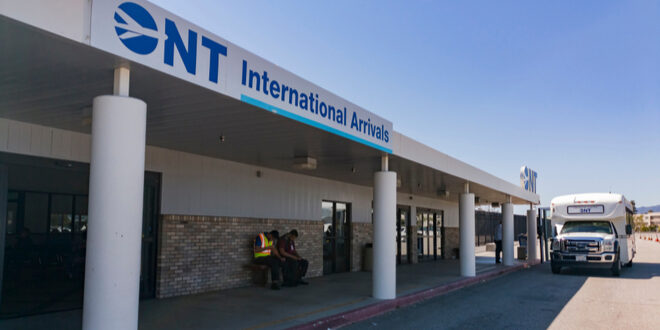Six years after achieving local ownership, airport officials released a report detailing how much the airport has thrived during that time. Some who fought to get the airport away from the city of Los Angeles say that’s exactly what they expected to happen.
Apparently, the people who for years argued that Ontario International would only prosper if it came under local ownership were correct.
Six years after Ontario and San Bernardino County wrested ownership of Ontario International away from Los Angeles World Airports, the airport south of Interstate 10 is thriving.
Ontario International has become an “economic engine” not only for the Inland Empire but for all of Southern California, generating $3.8 billion in economic activity a year, according to a study by Oxford Economics, a global economic advisory firm based in Oxford, England.
Ontario International also supports 27,800 jobs and is the center of a logistics network that produces nearly $18 billion in goods and services a year.
The 22-page report was released Nov. 1, exactly six years to the day that LAWA, the Los Angeles agency that owns and operates Los Angeles International Airport, officially handed over control of Ontario International.
More than 300 Inland officials and local dignitaries marked that historic event at a State of the Airport gathering held the day the document was released.
The report, which took nearly one year to compile, notes that Ontario International is now one of the top 10 cargo airports in the United States, due in part to two major developments there since the fall of 2016: Fed Ex Express’ development of a $290 million facility, and UPS’ opening of its western regional air hub, which is able to process 400,000 packages a day.
Also, last December, Ontario International was named the fastest growing airport in the United States by Global Traveler, an aviation trade publication, according to the report.
The airport is helping to drive much of the Inland region’s economic growth, said one local official who fought hard to bring the aviation facility under local control.
“Ontario International is more than an airport, it the heart of one of the fastest-growing population and economic centers in the U.S.,” said Alan D.Wapner, president of the Ontario International Airport Authority’s board of commissioners and Ontario’s Mayor pro tem, in a statement.
“It provides a foundation for solid economic growth for years to come, and is the public treasure we envisioned for Ontario and San Bernardino County.”
One person who argued passionately in favor of local control of Ontario International said he is not surprised at how well the airport is performing today.
“If it hadn’t been for COVID all of this would have happened a lot sooner,” longtime Inland economist John Husing, now retired, said. “Once it got out from under the influence of the city of Los Angeles it started doing a lot better. They’ve done a remarkable job of marketing the airport. It has really grown and improved.”
Husing, who spent more than four decades studying the Inland Empire economy, was passionate about getting ownership of Ontario International away from Los Angeles. During one memorable addressed, he declared that LAWA officials should “burn in hell’ for their neglect of the Inland region’s major commercial airport.
A decade or so later, his opinion hasn’t changed.
“LAWA was willing to sacrifice Ontario International in order to pay for their improvements at Los Angeles”, said Husing, who said Ontario International would be “like a man with one leg” if it was still owned and operated by LAWA. “That was their strategy, but I think they knew they couldn’t do that forever. They knew that eventually they would lose in court.”
Greg Devereaux, former San Bernardino County chief executive officer, is probably the person most responsible for getting Ontario International Airport away from LAWA, according to Husing.
“He was San Bernardino County’s CEO, and before that he was Ontario’s city manager,” Husing said. “He was perfectly positioned to get the lawsuit filed that finally settled the issue.”
Ontario International began in 1923, when Latimer Field – named after a nearby orange packing company – was established near Central Avenue about three miles from where the airport is today, according flyontario.com, the airport’s website.
Six years later, Ontario bought 30 acres at the southwest corner of Ontario International’s present location and renamed the facility Ontario Municipal Airport. “International” replaced municipal in 1941, when cargo flights from there began crossing the Pacific Ocean.
In 1967, Ontario and the Los Angeles City Department of Airports signed a joint powers agreement that made Ontario International part of Los Angeles’ regional airport system.
That arrangement began to fray in 2008, when the Great Recession hit and LAWA made Los Angeles International its top priority, said Frank Williams, former head of the Baldy View Chapter of the Building Industry Association of Southern California.
“Probably the hardest thing was convincing them that [local control] was the right thing to do,’’ said Williams, who now lives in Florida.
Williams helped form the Ontario Airport Alliance, an ad-hoc group of civic and business leaders who supported local control of the airport.
“The city council stepped up and helped lead the effort,” Williams said. “At that point LAWA, and later on [Los Angeles Mayor] Eric Garcetti, [elected in 2017] had to take us seriously, and things started moving quickly.”
Ontario International expects its passenger count for this year to reach 5.8 million, about 200,000 more than it had in 2019, said Steve Lambert, airport spokesman.
“We’re finishing up a pretty strong year,” Lambert said.
 IE Business Daily Business news for the Inland Empire.
IE Business Daily Business news for the Inland Empire.


